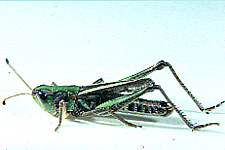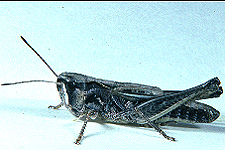Grasshoppers of Wyoming and the West
Entomology
Aeropedellus clavatus (Thomas)
 |
 |
| Adult male | Adult female |
Common name - Club-horned grasshopper (Helfer, 1972) or Slant-faced grasshopper (Pfadt, 1972).
Geographic distribution - an alpine and boreal grasshopper found from Minnesota and southern Canada to the Yukon and Alaska. It also is found in Iowa, the Dakotas, Montana, Idaho, Nebraska, Colorado, Wyoming, Utah, Arizona and New Mexico (Brooks, 1958; Otte, 1981). In Colorado it is found from the lower edge of the foothills to above timberline and occasionally on the Colorado plains. It lives at a higher altitude than any other Acridian (Alexander and Hilliard, 1964).
Colorado Distribution Map - Aeropedellus clavatus (Thomas)
Habitat - prefers the lower hills and grassy plains of North Dakota (Mulkern et al., 1964). In Canada it has been seen frequently on sandy soil (Brooks, 1958). Colorado habitat is mainly the alpine tundra (Alexander and Hilliard, 1964).
Food habits - grasses and sedges are preferred foods with bluegrass being the main food in North Dakota. Other preferred foods are threadleaf sedge, Sandberg bluegrass, Idaho fescue, Junegrass, rubber rabbit brush, scarlet globemallow, sand dropseed, cheatgrass brome, western wheatgrass and sixweeks fescue (Anderson and Wright, 1952; Brooks, 1958; Kumar et al 1976; Mulkern et al., 1964; Ueckert, 1968).
Eggs - eggs are whitish, three to seven per pod. They are arranged in two rows within a dark brown pod. Average egg length, 5 mm; average diameter, 1.5 mm (Alexander and Hilliard, 1964; Onsager and Mulkern, 1963).
Nymph - four instars (Alexander and Hilliard, 1964).
Adult - medium size. General color is green or brown. Face is slightly slanted back. Vertex is rounded. Antennae are slender and yellow with dark-brown tip enlarged to a club. Dorsal posterior margin of prontoum is rounded. Lateral carinae of prontoum are strongly constricted anterior to middle. Wings and tegmina are the same length as abdomen in male. Females are short winged. Tegmina and wings are clear. A dark patch is on the sides of each abdominal segment. Hind tibiae are yellow to brown. Male length, 19 mm; female, 28 mm (Ball et al., 1942; Froeschner, 1954).
Males are easily frightened and seem to be constantly flying or crawling rapidly on the ground. Females are much slower and remain motionless for long periods of time (Anderson and Wright, 1952).
Oviposition - females lay eggs in the base of sedges and grasses and among roots (Alexander and Hilliard, 1964).
Seasonal history - eggs hatch from mid-May to early June. Adults are abundant in mid- to late-July with some persisting through September (Mulkern et al., 1964).
Abundance and importance - abundant in alpine tundra (Alexander. 1964). In Canada it occasionally has caused extensive damage to range grasses (Brooks, 1958).
A. clavatus fact sheet from the Field Guide to Common Western Grasshoppers
Next Species: Ageneotettix deorum
Previous Species: Aeoloplides turnbulli
Biology of Common Colorado Grasshoppers List
Biology of Common Colorado Grasshoppers

